How Aryna Sabalenka Rebuilt to the Top
Ahead of the U.S. Open, a look back at Sabalenka's remarkable biomechanical transformation with Gavin MacMillan
NEW YORK — As Bounces reported a few days ago, one of the biggest storylines heading into this year’s U.S. Open is Coco Gauff making a change to her coaching team shortly before the tournament, adding biomechanics expert Gavin MacMillan to help rebuild her serve.
Gauff has struggled with another spate of double faulting in recent weeks, and so MacMillan would seem like the perfect fit to fix that issue, after his remarkable success transforming the career of one of Gauff’s rivals.
Aryna Sabalenka was the quintessential ball basher early in her career, swinging big but blowing hot and cold with a game that was wild and untamed. But as you will read in this excerpt from Molly McElwee’s new book Building Champions: Paths to Success in Women’s Tennis, her willingness to trust MacMillan and rebuild her game allowed her to make a remarkable evolution into the sturdiest and most consistent presence atop the women’s game.
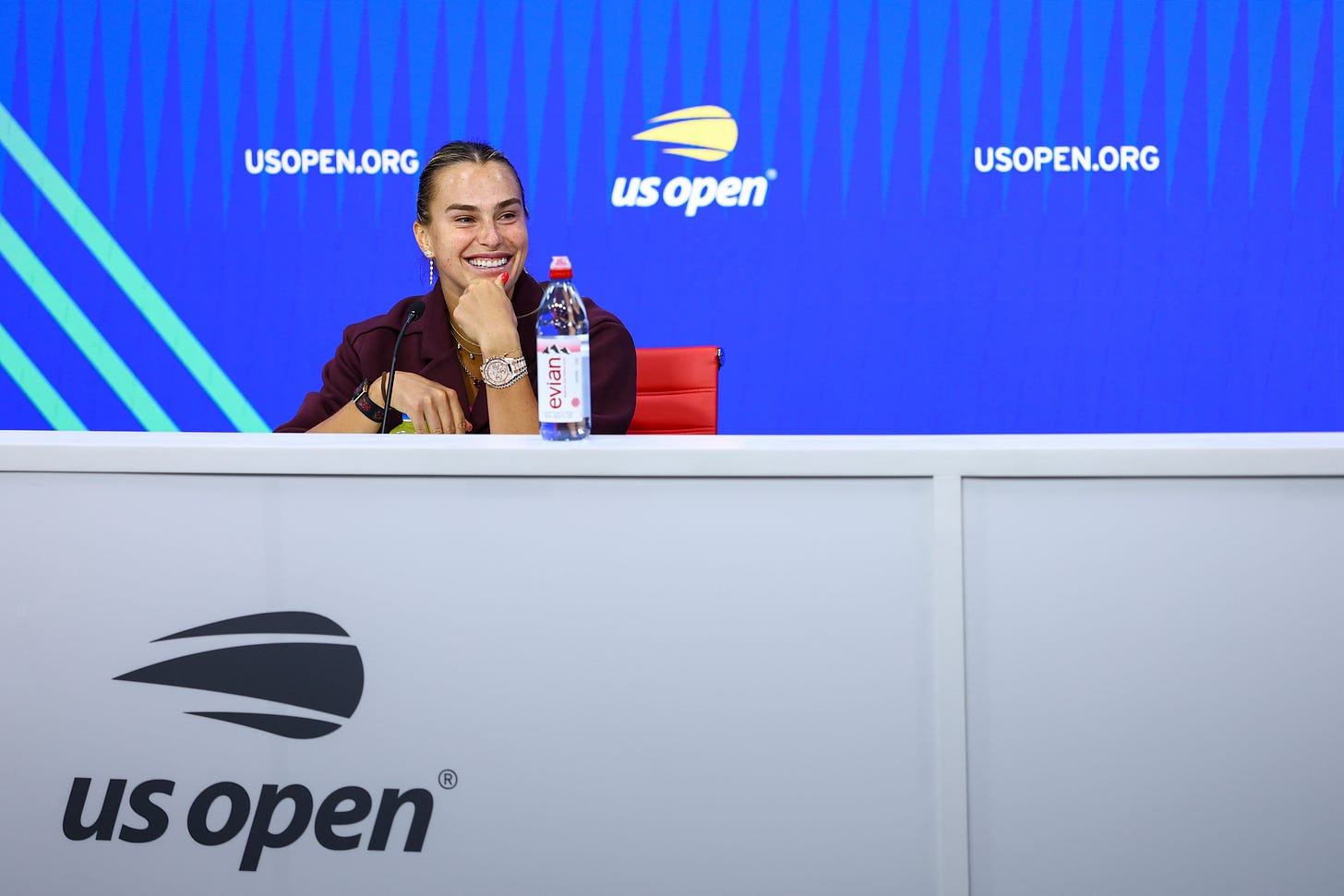
Molly and I had already been discussing running this excerpt on Bounces to set up Sabalenka’s return as U.S. Open defending champion, but once MacMillan arrived back on center stage, this story became even more timely. I do hope you enjoy it, and also that you consider buying the book stateside at Bookshop or Barnes & Noble, in the UK at Waterstones, and checking out Molly’s Substack!
This is an extract from Building Champions: Paths to Success in Women’s Tennis by Molly McElwee, published by Arena Sport (an imprint of Birlinn). It is out now. This excerpt has been condensed and lightly edited for Bounces.
In her first two matches of the 2022 season, Aryna Sabalenka leaked 39 double faults on her serve. One of those was a 21-double fault loss to qualifier Rebecca Peterson, where she smashed her racket to the ground in despair and was sobbing between games and even between points. As she desperately resorted to underhand serving, the umpire intervened to ask if she was injured. “Nothing is wrong,” Sabalenka said flatly. “It’s a technical problem. I cannot serve better.”
A couple of weeks later at the Australian Open, she hit six double faults in the very first game of her second round match. Somehow she still won and, when she reached the fourth round later that week, her first reaction was that she was ‘mostly happy that I made only 10 double faults’. This was one of the best players in the world, ranked inside the top five, but she was operating at such a dire level that 10 double faults were considered a good day at the office. Throughout 2022, Sabalenka racked up 428 double faults across 55 matches – 139 more than any other player on the women’s tour. One in every 10 points on her serve resulted in a double fault.
Away from the raw numbers, the impact this was having on her self-esteem was disastrous. Sabalenka is six foot tall, has broad, strong shoulders and is a real presence on the court. She competes fiercely, and she is one of the loudest players too. On the outside, she was the picture of confidence. But Sabalenka was starting to be known by opponents as the kind of player who beat herself. All they had to do was hang in during matches against her, and she would almost inevitably get tight and completely lose control of her biggest weapon, the serve, as well as her groundstrokes.
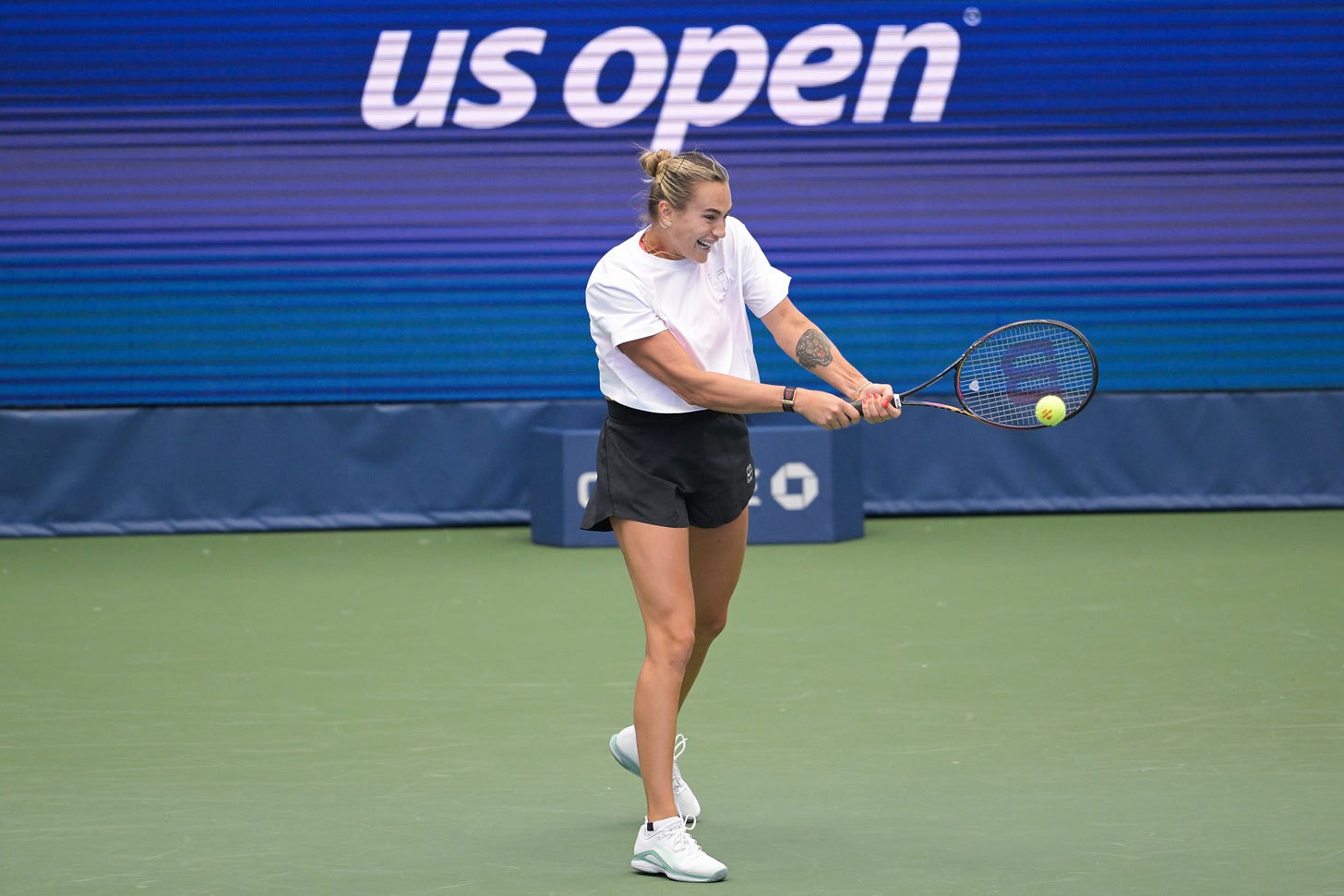
The mental anguish experienced by a player with the yips cannot be underestimated. Seventeen-year-old Anna Kournikova famously suffered from them between October 1998 and January 1999, recording a whopping 182 double faults across just 10 matches. Sabalenka’s own start to 2022 was a continuation of a long period in which her serve had been running hot and cold, with no real way to know when it would suddenly fail her.
There is something perversely fascinating about watching an elite athlete suddenly find themselves unable to perform an action that should be simple. At her worst, Sabalenka was serving without even rising to the ball, her feet planted to the ground, her left hand tossing up the ball and her right arm merely going through the motions. Even hitting at 50 per cent power, with an aim to simply get the ball over the net, she still often failed. The ball would either hit the middle cushioning of the net or it would sail over and far beyond the service line. She groaned and grunted with every miss, rolling her eyes in that animated way of hers, gesturing exasperatedly up at her team in the stands or chastising herself in Russian. Sabalenka went from being one of the fiercest competitors in the sport, prone to wild shouting and big, bold celebrations, to being a shadow of herself at times. It was hard to watch, but you almost couldn’t look away either, so unfathomable was it to see this firecracker server reduced to such lows.
“The risk in golf or tennis is different to gymnastics: it’s about other people’s perception of you, that feeling of failure, inadequacy and humiliation,” said sports psychologist Dr. Misia Gervis, who has worked with athletes across those sports. “These are big feelings that start to show up.”
Putting herself through that every couple of days, in front of thousands of spectators and more watching on television, only exacerbated the issue for Sabalenka. With every match she won or lost, she was asked about her serve by the media. Much was written about Sabalenka’s chronic case of the yips and plenty of theories abounded about what could be done about the problem.
Gavin MacMillan was watching from afar, and he was unconvinced: “You had everybody in the world telling her it’s a mental thing, she’s got the yips. That is such an extraordinary disservice to her and to what’s going on. It’s not the yips. It’s not mental. She’s flat out doing it wrong. And the fact that she was having any success at all is shocking.”
MacMillan is a biomechanics specialist, and founder of the Sports Science Lab. His previous client list includes all-time great boxer Manny Pacquiao, Super Bowl champion Will Blackmon and nine-time major champion Monica Seles. He is also as straight-talking as they come. He was first introduced to Sabalenka’s coach, Anton Dubrov, in Indian Wells, March 2022. A few weeks earlier, Dubrov had literally told Sabalenka: “I don’t know what to do. I think you need to find someone else who’s going to help you.” She immediately rejected his resignation. He couldn’t quit on her, she argued; they would work through things. Sabalenka was reluctant when Dubrov first brought up the idea of getting MacMillan involved.
It took five months for her to come around. MacMillan got a second call from Dubrov after Sabalenka suffered a three-hour, 11-minute loss to Coco Gauff at the Canadian Open in Toronto that August. She hit 18 double faults in that epic against Gauff, after notching up a grand total of 59 in the previous three matches. She had reached breaking point. After that match she sat on the floor in tears, ruing how she had tried just about everything to fix her serve and nothing had worked.
MacMillan was at his friend’s ranch in Fresno, California, when he picked up the phone. He told Dubrov he needed to speak with Sabalenka herself to make sure she was on board and after asking her if she was okay (“No,” was the reply), he laid out his pitch.
“The fact that you still compete so hard tells me everything I need to know,” he told Sabalenka. “And I can 100 per cent promise you this isn’t mental.”
Sabalenka, confused, asked: “How can you promise that?”
“Because you’re doing it so wrong,” MacMillan said of her technique. “How would anyone say it’s mental if they look at your film properly and look at what your left arm’s doing – it’s dropping so far down, pulling your right shoulder down. And your right arm’s wrong too, you’re not doing either one of them right – and I can prove it. I can fix this.”
The next day, he was on a plane to Toronto. By Saturday, 36 hours after their initial call, he was on the court with Sabalenka. He started by getting her to make some simple physical adjustments and gave her a task to hit 10 serves in a row at a specific target, using his new tip. She was not allowed to stop until she hit his mark without fail. “She did it the second time she tried,” MacMillan says. “I told her: ‘Well, it’s not mental or you wouldn’t be able to do this.’”
The truth is, Sabalenka’s issues were neither totally technical nor totally psychological: the two were coexisting together. It became clear to MacMillan just how deep this serving issue ran for Sabalenka who, he claims, had experienced some particularly harsh coaching from a young age. “I couldn’t have predicted what I was dealing with. You’re dealing with such a huge amount of fear of her not being able to do it, of previous coaching that had been done with her – which was nothing short of what I’d call abusive, I guess. The information she was given was dead wrong, but childhood coaches would yell at her. What happens is when a coach doesn’t know what they’re doing, then you blame the player. She had that experience.”
From Dr. Gervis’s viewpoint, in the majority of cases of the yips, they are rooted in some kind of trauma or negative experience – either on or off the court. “In the instances where I’ve worked with people, there’s something that sits beneath it. It doesn’t just come in a vacuum of everything’s fine and lovely. Once you dig a little deeper, and deal with the underlying trauma, often then that resolves the issues.”
MacMillan could see the mental toll that year—including the consequences she’d faced as a Belarusian player after Russia’s invasion of Ukraine—had taken on Sabalenka, but remained adamant that this was a physical issue that was the result of poor coaching advice she had received during her developmental years. Beyond Sabalenka’s specific case, MacMillan does not mince his words when it comes to describing the level of coaching he thinks exists in tennis. As he works in other sports, he says he is immune to the tennis bubble, and says the standards vary massively.
“You get these people who are beyond incompetent – they are making it up as they go along,” he says. “If you are witness to this, you can’t believe how unprofessional most of it is, and the fact that these girls still find a way to succeed is shocking. What they do on the women’s side – and it happens more on the women’s side – is they establish emotional relationships with them, and they develop a connection that way. When you don’t have knowledge but you get lucky enough to stumble upon somebody that’s good, well, then you cling to them, because you know that’s your only way of surviving. It’s like a lifeboat. But if you know what you’re doing, the last thing you’re worried about is getting fired.”
When it came to working with Sabalenka, MacMillan saw immediate improvements. Her four matches prior to working with him, she averaged 19 double faults per match, the next four she averaged seven. But not every element of the service motion was a quick fix. Showing her how to lift her left arm further in the toss and get her to twist her right arm to get the racket facing the correct way was his main aim.
To the average person, these changes may be more subtle, easy to miss. For MacMillan, the mistakes were glaringly obvious. “The right arm has been a really long process to try to fix because she’s always opened it and pointed her racket to the back fence. Like, you’re screwed the minute you do that. And getting her brain around trying to change that, that has not been simple.”
Getting her to do that consistently right was a challenge. As well as the technical adjustments, there is also the mental impact of years spent lacking trust in a shot that should be your strongest. With MacMillan’s help, she turned a corner in the latter stages of that season. She reached the semifinals of her first two events with him in her team, at Cincinnati and the US Open, to help her qualify for the WTA Finals, where she finished runner-up.
“This year I was fighting with myself, which is a completely different fight,” she said. “I learned a lot about myself. I think this season started as the worst season, but at the end I think it was the best season for me because I learned a lot, and I became even stronger, and like mentally stronger.”
Shane Liyanage, Sabalenka’s data analyst, thought Macmillan was “the missing piece for Sabalenka.”
“Of course, getting Gavin involved was critical,” Liyanage said. “What he rightly identified was there were issues with the technique and, while she got away with it and served amazingly some days, I think the flaws in the technique were really showing under pressure. I really credit the work he’s done improving the serve, but also the other strokes. He doesn’t get the recognition for the work he did on her forehand, even the backhand, just resetting under pressure. Anton as well, the work he did throughout the year to reinforce that. We all played a little bit of a role to get that information to her, and she had to mature as a person to accept that help as well.”
The biggest piece of information they all delivered was that she was not at her most effective when she played at 100 percent. Her sweet spot, where she won the most points and caused her opponents the most issues, was actually 85. The data was showing Liyanage that if she hits her forehands with the shape her new technique was giving her, at 85 percent power and with a 2,400 revolutions per minute (nearly 300 above the rest of the tour), she is only losing 30 percent of points.
“She’s dominating,” Liyanage told MacMillan. “That makes the ball a lot more challenging, jumping out of her opponents’ strike zone and still faster than most other girls on tour can hit.”
MacMillan describes it as increased heaviness on her forehand shot in particular. “The change in her forehand has been more dramatic than her serve,” he says.
One big difference in the numbers was that her first-serve speed dropped by 10kmh on average at the 2023 Australian Open from the previous year. It meant she was following Liyanage and MacMillan’s 85 percent rule, and the results were more consistent. On her way to the final, she did not drop a set.
After clawing her way back into that final against Elena Rybakina, a classic many regard as one of the best women’s finals in recent memory, Sabalenka showed some of the traits of old while serving for the title. [Cued up to that moment in the video below]
On her first championship point, she hit a double fault. She screamed at herself. On the second match point, when she missed her first serve, the crowd groaned. She didn’t double fault, but she hit a wild error. The nerves were jangling, and she sent another backhand long on her third match point. When she eventually clinched it by finally making a first serve and drawing the error from Rybakina, she lay on her back and cried with relief.
MacMillan watched from home in South Africa. The main thing that stood out was how Sabalenka problem-solved and committed to that new shape she had switched to on her forehand side.
“In those really big points she really trusted it and got an error from Elena out of it,” MacMillan said. “If you looked at where she was four months before, and said: ‘We’re going to win the Australian Open.’ Like, no, that’s not an option. And you’re going to be in the finals and semifinals of all the others for the rest of the season? Again, no way. But it happened.”
Winning the Australian Open again the next year, as well as the 2024 U.S. Open, brought Sabalenka’s major total to three. Three slams is already a haul most would be delighted with; Sabalenka’s high standards suggest she is aiming for much more though, and it is hard to see her stalling.
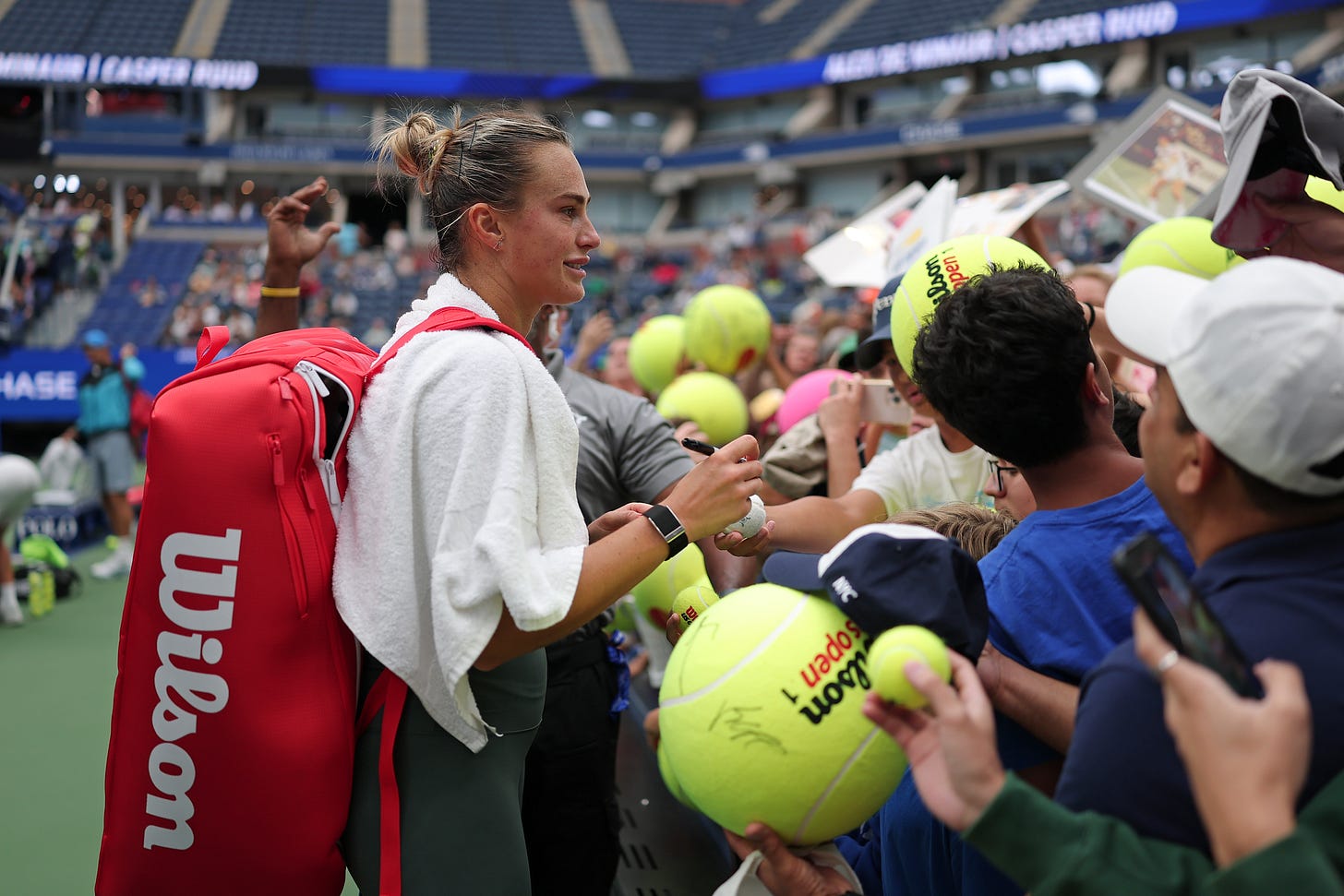
From when she first started dismantling her serve in August 2022 up through Wimbledon 2025, she won three major titles, and reached at least the semi-finals of ten out of eleven Grand Slams played. In the one she didn’t, she still made the quarterfinal. No player in the sport can boast such an emphatic record in recent years. For someone who had previously only been beyond the fourth round at a major twice in her career, it is all the more impressive. She has gone from flaky to the most consistent player in women’s tennis.
“If there’s a better turnaround in sports in the last 25 years,” MacMillan says, “I want to know what it is.”
Thank you for reading! If you enjoyed this excerpt from Building Champions, please do consider buying the book stateside at Bookshop or Barnes & Noble, in the UK at Waterstones, and subscribing to Molly’s Substack!




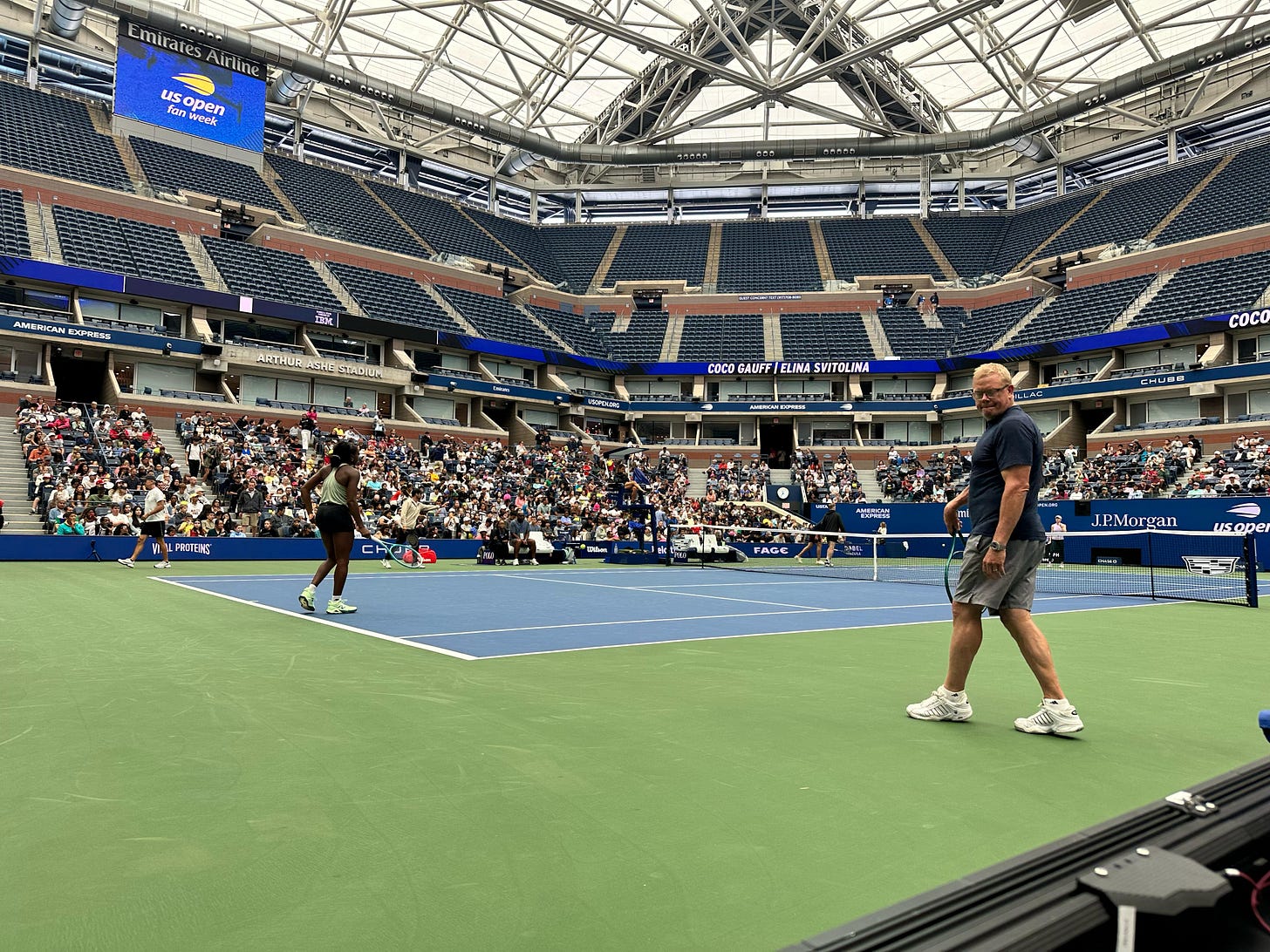

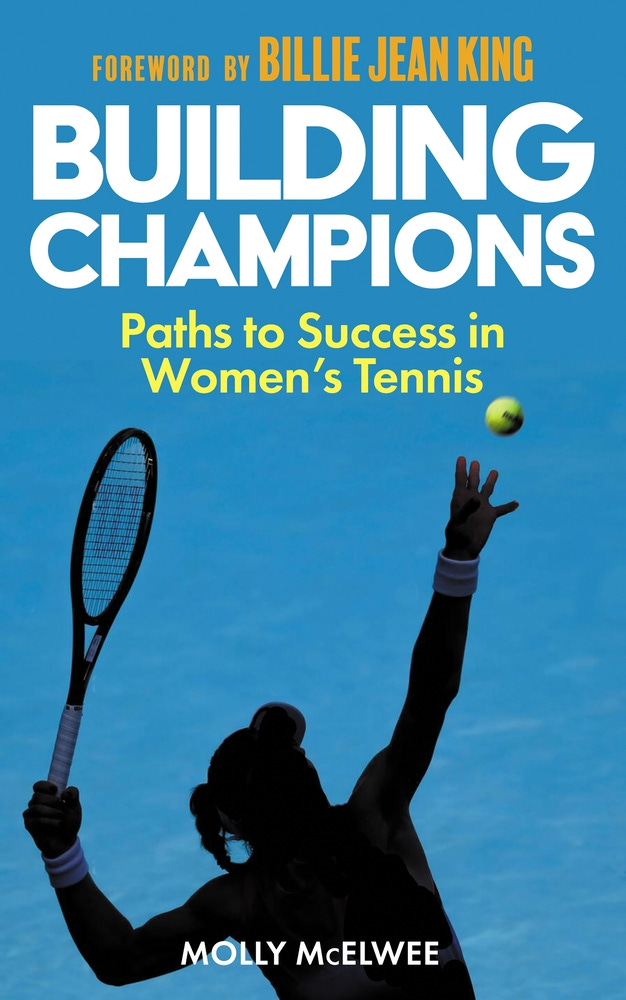

excellent, i ordered the book
Great article. Molly's book is excellent.